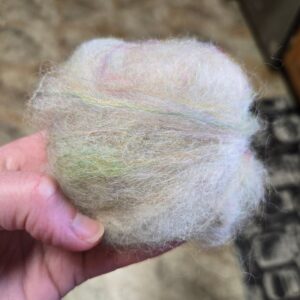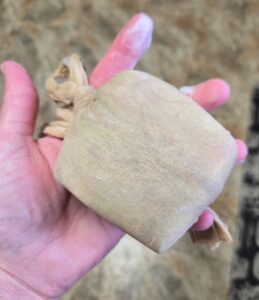Making felted soap is fun and easy. All you need is a bar of soap, some natural fiber like mohair or wool, water, and your hands! Follow these steps to create a gently exfoliating, long-lasting, and beautiful way to wash. Instructions for decorating your felted soap are also included.

This post contains affiliate links. As an Amazon Associate, I earn from qualifying purchases.
I am a soap maker and fiber artist. Making felted soaps is a way for me to combine two of my favorite things!
I make cold process soap with milk that I get from my herd of Nubian dairy goats. It is moisturizing, gentle, and has amazing lather. For more on the benefits of goat milk soap, click here to read my other article.
I also raise Angora goats and process their mohair right here on our farm. For instructions on shearing, scouring, and combing mohair, follow the links to my other how-to articles.
If you aren’t a soap maker or don’t have your own fiber animals, don’t worry! Making felted soap is fun and easy and you can purchase all of the materials you need to get started.
Why Felted Soap?
Felted soaps last three times longer than regular bars of soap. The fiber protects the soap and wicks away moisture so that it dries more quickly and none of it goes to waste. After use, felted soap should be placed on a soap rest or dish that allows for drainage and air flow.
The fiber in a felted bar of soap acts as a gentle exfoliator while you are washing with it, eliminating the need for a washcloth, soap-saver bag, or loofah. Plus, when your felted soap gets used up completely, you are left with a fiber scrubby that can be used for cleaning other things!
Felted soaps are beautiful and make great gifts! Using a felted bar of soap can add some fun to anyone’s normal handwashing or showering routine.
Let’s make some!
Materials Needed for Making Felted Soap
- A bar of soap
- At least an ounce of natural fiber
- Nylon stocking
- Bowl
- Hot and cold water
- Optional: Felting needles and colored fiber
You can use any kind of bar soap for your felting project. Handmade soap is great, but you can also use Ivory, Irish Spring, or whatever is your favorite. If you are using handmade soap, make sure that it is completely cured before you felt it.
It is easiest to felt a round or oval-shaped bar of soap, but I make square-shaped goat milk soaps and they felt just fine with a little extra patience working on the corners. To help round the corners before I start felting my rectangular bars, I use a vegetable peeler!
You will need 100% natural fiber to create felted soaps, synthetics or synthetic blends will not felt. I have access to mohair from my Angora goats, but any type of wool or alpaca will work too. You can use roving, combed top, or a batt of fiber to create felted soaps. Preparations that do not align the fibers work best for felting.
A nylon stocking helps you begin the felting process and adapt the fiber to the bar of soap. You can use a knee-high or just cut an old pair of nylon stockings down to size.
You will start felting with a bowl of hot water and then can rinse your felted soap in cold tap water from your sink.
If you want to decorate your felted bars of soap, you can use felting needles and colored fiber. Any size felting needles will work and you can use a single needle tool or a multi-needle tool.
I recommend using felting finger protectors because felting needles are extremely sharp and it is easy to stab yourself! I wear them on the thumb and index finger of my non-dominant hand while I am felting. Mine are made of leather and they work well and are comfortable.
There are templates that you can buy to help you make basic designs on your felted soaps. I made the heart shape that you see in the picture with a template. You can freehand your own design too!
Directions for Making Felted Soap
- Select a bar of soap for the felting project, if it has sharp corners, round them by using a vegetable peeler
- Weigh out the fiber that you want to use, one ounce is the minimum that I use to cover my 4- ounce bars of square-shaped goat milk soap. You can use more if you wish, but it may take a little extra time to felt
- Get the bar of soap wet at the sink
- Wrap the bar of soap in your fiber, make sure that it is completely covered and you can’t see the soap through the fiber. If you can see soap still, add more fiber. The fiber should stick to the wet soap bar.

- Put the fiber wrapped bar of soap into the nylon stocking. Push it down to the toe and tie a knot in it so that it is closely adhered. You can tie a slip knot so that the stocking is reusable!

- Run hot water into your bowl.
- Submerge the stocking with the fiber wrapped soap in the bowl of hot water.
- Take it out and with your hands over the bowl, begin gently massaging the fiber and molding it around the bar of soap. It will get sudsy, so use the bowl to catch the lather than comes off your hands.
- Continue massaging the bar of soap in the nylon stocking for at least 5 minutes.
- Now you can remove the bar of fiber covered soap from the stocking.
- Continue massaging the soap in your hands for at least 10 minutes. You should feel the fiber begin to tighten around the soap and it will have less “squish” to it when it is completely felted.
- When you are done felting the soap, rinse it in cold water. The cold water will “shock” the fiber and will help with the final felting process.
- Allow your felted soap to dry, undisturbed for at least 24 hours.
- Now you can use your felted soap, or you can needle felt a design onto it.
- If you want to make a design, use felting needles, finger protection, and colored fiber. A template is helpful to get started. All you have to do is stab into the felted soap over and over again until the added fiber is flush with the original fiber.
- Use your felted soap!
Additional Notes About Felted Soap
- As previously mentioned, between uses, store felted soap on a soap rest or dish that allows for drainage and air flow
- The soap will continue to felt with use, the fiber should remain closely adhered to the bar of soap as it shrinks, until the soap is completely gone
- Over a period of weeks, the soap will get used up, leaving behind a fiber scrubby that can be used to clean with
- Needle felted designs on the bar of soap may become distorted as the soap is used
- If you enjoyed felting, another project you can try is making felted dryer balls. Click here for the details!

Mother, farmer, author, and teacher by trade… She loves tending to things and watching them grow!
